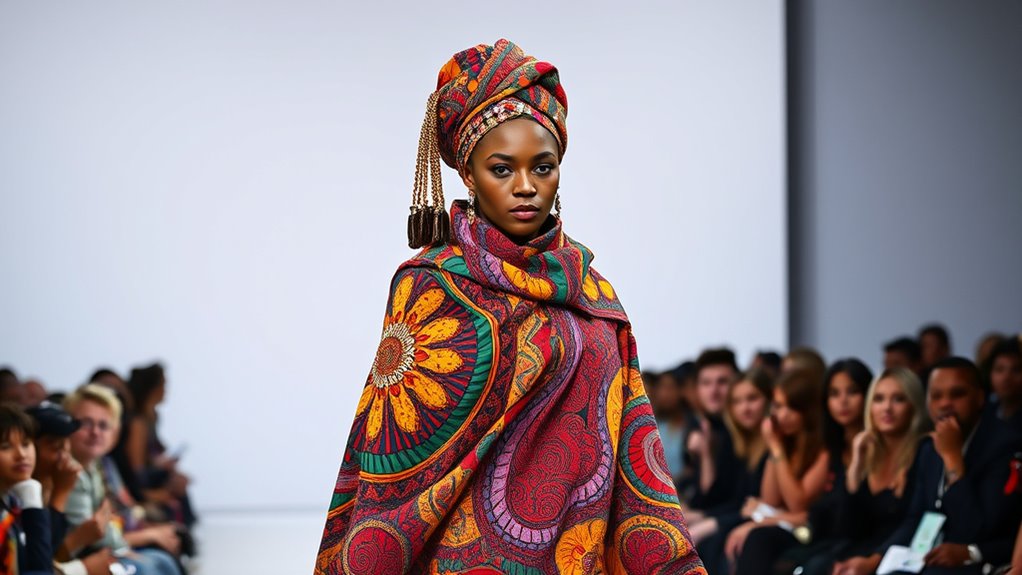Fashion becomes controversial when designers or celebrities use cultural symbols and traditional attire insensitively or without understanding their significance. Moments like the 2015 Met Gala dress, Rihanna’s dreadlocks, or Gucci’s blackface-inspired sweater spark debates about respect, authenticity, and cultural ownership. These controversies highlight the importance of cultural awareness and using symbols responsibly. If you continue exploring, you’ll discover how these moments shape conversations about ethics, respect, and representation in fashion.
Key Takeaways
- Notable moments like Rihanna’s dreadlocks or Kim Kardashian’s kimono-inspired shapewear sparked debates over cultural appropriation and insensitivity.
- The 2015 Met Gala’s indigenous-inspired headdress drew criticism for disrespecting cultural symbols and traditions.
- Gucci’s blackface-inspired sweater caused widespread outrage, highlighting the importance of cultural awareness in fashion.
- Music videos and celebrity styles increasingly borrow cultural elements, prompting discussions on artistic expression versus stereotypes.
- Digital platforms amplify these controversies, emphasizing the need for cultural sensitivity and cybersecurity awareness.
The Cultural Clash of the 2015 Met Gala Dress
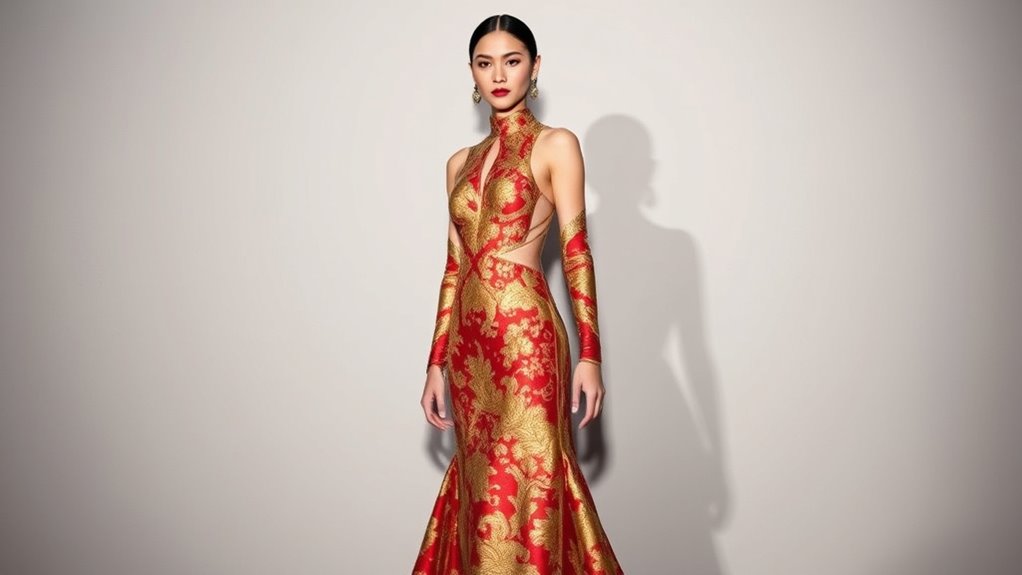
The 2015 Met Gala dress sparked widespread controversy because it highlighted a cultural clash that many found offensive. The design featured a bold, elaborate headdress and costume inspired by indigenous cultures, raising questions about cultural sensitivity. Some viewed it as a display of fashion innovation, pushing boundaries and celebrating diversity. However, critics argued it crossed the line into cultural appropriation, disrespecting sacred symbols and traditions. As you observe this moment, you see how fashion can serve as a double-edged sword—fostering creativity while risking insensitivity. It underscores the significance of understanding cultural contexts when merging fashion with cultural elements. This controversy sparked essential conversations about respecting cultural identities, prompting designers and audiences alike to consider the impact of their choices. Additionally, the incident highlights how cybersecurity vulnerabilities can be exploited when digital platforms are used to amplify or criticize such controversies, emphasizing the importance of digital safety in the modern era. Recognizing the role of cultural awareness in fashion decisions is crucial for fostering respectful creativity and avoiding missteps. Furthermore, this event exemplifies how cultural expression in fashion can unintentionally lead to misunderstandings if not approached thoughtfully.
Rihanna’s 2018 Met Gala and the Dreadlocked Debate

Rihanna’s 2018 Met Gala look ignited a fierce debate over cultural expression and authenticity when she appeared with her hair styled in long, thick dreadlocks. Many saw her hairstyle as a bold form of fashion activism, challenging notions of cultural sensitivity. Critics argued it appropriated a significant cultural symbol, sparking conversations about respect and representation. Others praised her confidence in embracing cultural elements and using her platform to highlight diversity. To visualize her look, consider this table:
| Aspect | Description | Cultural Significance |
|---|---|---|
| Hairstyle | Long, thick dreadlocks | Symbol of African heritage |
| Outfit | Bold, culturally inspired attire | Cultural pride and activism |
| Audience Reaction | Mixed emotions, debate | Cultural sensitivity at heart |
| Designer | Fashion activism statement | Challenging norms, sparking dialogue |
| Public Discourse | Cultural appropriation versus appreciation | Ongoing debate on cultural expression |
Additionally, Rihanna’s choice to wear dreadlocks sparked broader conversations about the importance of cultural representation and the boundaries of fashion as a form of social commentary. Recognizing the significance of biodiversity in cultural symbols can help foster a more respectful appreciation of diverse traditions and practices. Moreover, understanding the historical context behind such symbols is crucial for meaningful dialogue about cultural ownership and pride.
The Kim Kardashian Kimono Controversy

When Kim Kardashian wore a kimono-inspired outfit, many people called out cultural appropriation and questioned whether it showed disrespect to Japanese culture. The fashion industry faced backlash, with some defending her look and others condemning it as insensitive. You’ll see her issuing public apologies and the mixed reactions from fans and critics alike.
Cultural Appropriation Concerns
Kim Kardashian sparked widespread criticism when she released a shapewear line featuring a kimono-inspired design, igniting debates over cultural appropriation. Many argued that using traditional garments without respecting their cultural significance dismisses identity politics and perpetuates cultural insensitivity. Critics felt that her choice demonstrated a lack of awareness about the history and meaning behind kimonos, reducing them to fashion trends rather than symbols of cultural identity. This controversy highlights how fashion can cross into cultural boundaries, sometimes without understanding or acknowledgment. As a result, it prompts consumers and designers alike to contemplate the importance of cultural sensitivity and the impact of borrowing cultural elements in a way that respects their origins and significance. Additionally, understanding the role of cultural context in fashion can help prevent similar controversies in the future. Recognizing the significance of traditional attire and its cultural background is crucial in fostering respectful and inclusive fashion practices.
Fashion Industry Backlash
Did the fashion industry’s response to Kim Kardashian’s kimono-inspired shapewear line reveal deeper tensions about cultural sensitivity? Many designers and brands faced backlash for neglecting designer accountability when launching culturally inspired products. Critics argued that the industry often profits from cultural symbols without understanding their significance, risking insensitivity. This controversy heightened consumer awareness about cultural appropriation and the importance of respectful representation. Brands that dismissed these concerns faced public criticism, prompting a reevaluation of how cultural elements are integrated into fashion. The backlash underscored the need for greater accountability among designers, emphasizing that respecting cultural origins isn’t just ethical—it’s essential for maintaining credibility. Ultimately, the controversy served as a wake-up call, urging the industry to prioritize sensitivity and responsible design.
Public Apologies and Reactions
The backlash over Kim Kardashian’s kimono-inspired shapewear line prompted swift and intense reactions from both the public and the industry. In response, Kardashian issued an apology that focused on cultural sensitivity, employing apology strategies like expressing regret and acknowledging the offense caused. Public opinion quickly divided; some appreciated her acknowledgment, while others saw the apology as insincere or insufficient. Brands and celebrities learned that addressing controversy requires clear communication and genuine accountability. The incident highlights how public apologies can shape perceptions, either mitigating damage or fueling ongoing debate. Ultimately, the way you handle such situations influences brand reputation and public trust, emphasizing the importance of understanding cultural significance and responding authentically to maintain credibility.
The Use of Native American Symbols in Fashion
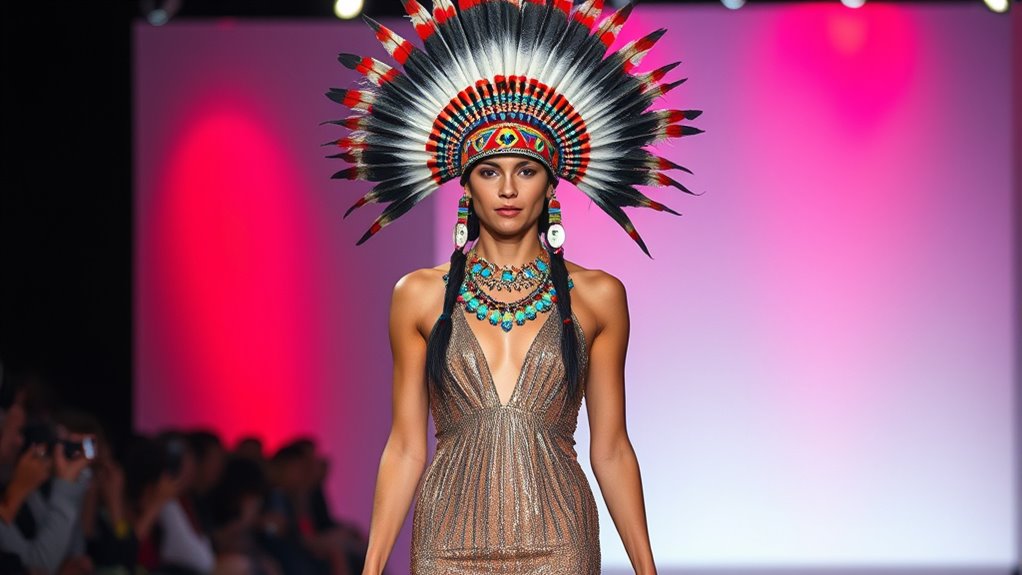
Many fashion brands have incorporated Native American symbols into their designs, often without respecting their cultural significance. This displays cultural insensitivity, reducing sacred motifs to trendy accessories. Using these symbols superficially dismisses their deep spiritual and cultural meanings, perpetuating stereotypes. Such appropriation can feel like identity theft, stripping communities of control over their heritage. When brands profit from sacred patterns or headdresses without understanding or honoring their origins, it causes real harm. You might see a headdress as a fashion statement, but for Native Americans, it’s a symbol of respect, bravery, and tradition. This misuse commodifies their culture, fueling misunderstandings and disrespect. Recognizing this issue is essential, as it highlights the importance of honoring cultural symbols rather than exploiting them for profit or aesthetic appeal.
The Gucci Sweater and the Blackface Backlash
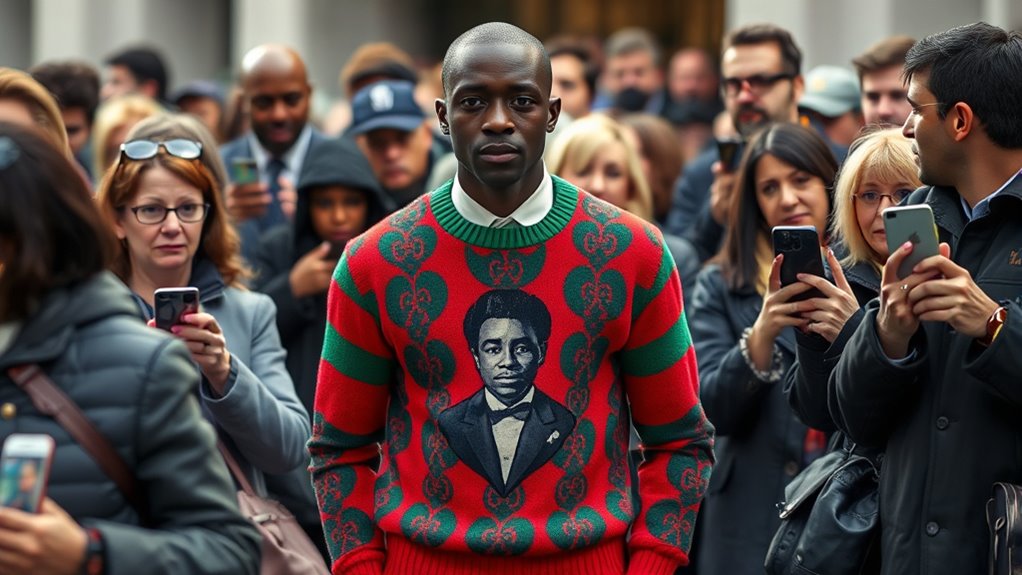
When Gucci released a sweater resembling blackface makeup, it sparked widespread outrage and accusations of racial insensitivity. Many felt it demonstrated a lack of cultural sensitivity and overlooked fashion ethics. The design featured a turtleneck with a red lip detail, reminiscent of historic blackface imagery, fueling criticism. To illustrate the controversy, consider this visual:
| Design Element | Cultural Impact | Public Reaction |
|---|---|---|
| Blackface-like mask | Offended communities | Apology issued |
| Red lips detail | Reinforced stereotypes | Calls for accountability |
| Overall design | Disregard for cultural sensitivity | Fashion brands criticized |
This incident highlights how fashion’s insensitivity can spark debates about respect and responsibility, emphasizing the importance of cultural awareness in design choices. Additionally, ongoing discussions about AI safety measures remind us of the need for vigilance in all fields to prevent harm and promote ethical standards. Recognizing the 16PF traits of designers and brands might help foster more culturally aware decisions in the industry. It also underscores the importance of cultural competence in fashion to avoid missteps and promote inclusivity.
The Debate Over Cultural Appropriation in Music Videos
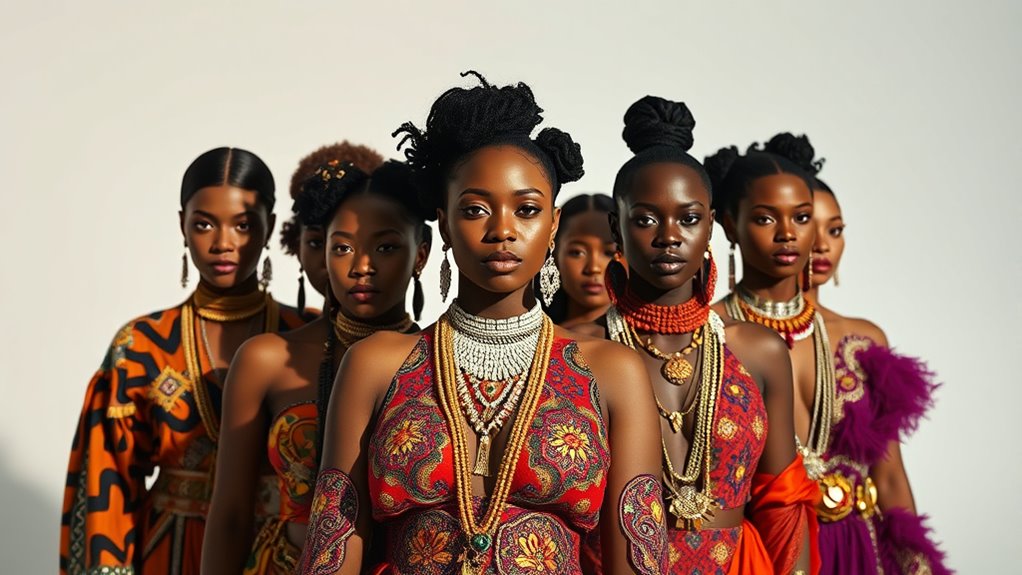
Cultural appropriation in music videos has become a heated topic as artists increasingly borrow elements from diverse cultures to craft their images and narratives. While some see this as artistic expression, others argue it shows a lack of cultural sensitivity. When you watch these videos, it’s important to weigh whether the artist respects the cultural origins or simply uses them for shock value. Critics say that crossing the line can reinforce stereotypes or erase the cultural significance behind certain symbols. Supporters claim it’s a way to celebrate different traditions. The debate centers on whether this practice promotes appreciation or perpetuates exploitation. As you analyze these videos, remember that acknowledging cultural sensitivity helps foster respectful dialogue while allowing artists to explore new creative avenues. Additionally, understanding the diverse designs of cultural symbols used in fashion can provide deeper insight into their significance and help avoid misappropriation. Recognizing the popular juice brands associated with health-conscious choices can also influence how cultural elements are perceived and appreciated in a global context. Moreover, examining the Vetted electric bike conversion kits can offer insights into innovative adaptations and the importance of respecting original craftsmanship in creative expressions.
Frequently Asked Questions
How Do Fashion Brands Typically Respond to Cultural Appropriation Accusations?
When faced with cultural appropriation accusations, you’ll notice fashion brands often respond by emphasizing brand accountability, issuing apologies, or removing the controversial items. They may also engage in dialogue to show respect and understanding. As consumer awareness grows, brands realize the importance of cultural sensitivity and tend to act quickly to address concerns, aiming to rebuild trust and demonstrate a commitment to respectful practices.
What Legal Actions Have Been Taken Against Designers for Cultural Insensitivity?
Legal repercussions against designers for cultural insensitivity vary, but some face lawsuits and fines for copyright infringement or trademark violations. In certain cases, communities seek designer accountability through legal channels, claiming cultural theft or misrepresentation. You should know that these actions aim to hold designers responsible, emphasizing respect for cultural identities. While legal measures aren’t always taken, increased awareness pushes brands to be more cautious, promoting cultural sensitivity in fashion.
How Does Cultural Appropriation Impact Minority Communities’ Perceptions of Fashion?
Imagine you’re in a world where cultural appropriation feels like a modern-day Woodstock—celebrated yet controversial. When designers ignore cultural identity, it damages community trust and perpetuates stereotypes. For minority communities, fashion becomes more than style; it’s a reflection of history and pride. Appropriation can make them feel disrespected or marginalized, leading to a disconnect that hampers genuine appreciation and understanding. Respecting cultural roots fosters trust and enriches fashion’s diversity.
Are There Differences in Cultural Sensitivity Between Western and Non-Western Fashion Industries?
You notice that western and non-western fashion industries approach cultural boundaries differently, often reflecting varying levels of awareness and respect for fashion ethics. Western industries may sometimes push boundaries without full understanding, risking cultural insensitivity. In contrast, non-western industries often emphasize preserving cultural identity. Recognizing these differences helps you understand the importance of respecting cultural boundaries and promotes more ethical fashion practices worldwide.
What Role Do Social Media Platforms Play in Shaping These Fashion Controversies?
It’s funny how social media platforms, meant to connect us, often fuel fashion controversies. You witness viral trends spreading in seconds, with influencers impacting opinions and sparking debates on cultural sensitivity. These platforms amplify voices that challenge traditional norms, making every outfit a potential battleground. Social media’s power in shaping perceptions is undeniable—what’s celebrated today could be controversial tomorrow, all driven by the rapid, viral nature of online culture.
Conclusion
So, next time you think fashion is just about style, remember it’s also about stepping into a world of controversy. You might wear a cultural symbol and spark debate, all while thinking you’re just making a statement. Ironically, in trying to stand out, you could end up tearing down. Fashion’s power lies in its ability to unite or divide—sometimes all in a single, stylish gesture. Who knew a trend could be so provocative?
